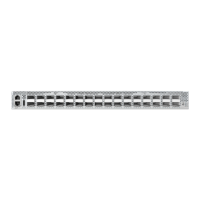C
HAPTER
14
| Basic Administration Protocols
Link Layer Discovery Protocol
– 349 –
◆ System Capabilities Supported – The capabilities that define the
primary function(s) of the system. (See Table 18, "System
Capabilities," on page 346.)
◆ System Capabilities Enabled – The primary function(s) of the
system which are currently enabled. (See Table 18, "System
Capabilities," on page 346.)
◆ Management Address List – The management addresses for this
device. Since there are typically a number of different addresses
associated with a Layer 3 device, an individual LLDP PDU may contain
more than one management address TLV.
Port Details – 802.1 Extension Information
◆ Remote Port VID – The port’s default VLAN identifier (PVID) indicates
the VLAN with which untagged or priority-tagged frames are
associated.
◆ Remote VLAN Name List – VLAN names associated with a port.
◆ Remote Protocol Identity List – Information about particular
protocols that are accessible through a port. This object represents an
arbitrary local integer value used by this agent to identify a particular
protocol identity, and an octet string used to identify the protocols
associated with a port of the remote system.
Port Details – 802.3 Extension Port Information
◆ Remote Port Auto-Neg Supported – Shows whether the given port
(associated with remote system) supports auto-negotiation.
◆ Remote Port Auto-Neg Adv-Capability – The value (bitmap) of the
ifMauAutoNegCapAdvertisedBits object (defined in IETF RFC 3636)
which is associated with a port on the remote system.
Table 20: Remote Port Auto-Negotiation Advertised Capability
Bit Capability
0 other or unknown
1 10BASE-T half duplex mode
2 10BASE-T full duplex mode
3 100BASE-T4
4 100BASE-TX half duplex mode
5 100BASE-TX full duplex mode
6 100BASE-T2 half duplex mode
7 100BASE-T2 full duplex mode
8 PAUSE for full-duplex links
9 Asymmetric PAUSE for full-duplex links
10 Symmetric PAUSE for full-duplex links

